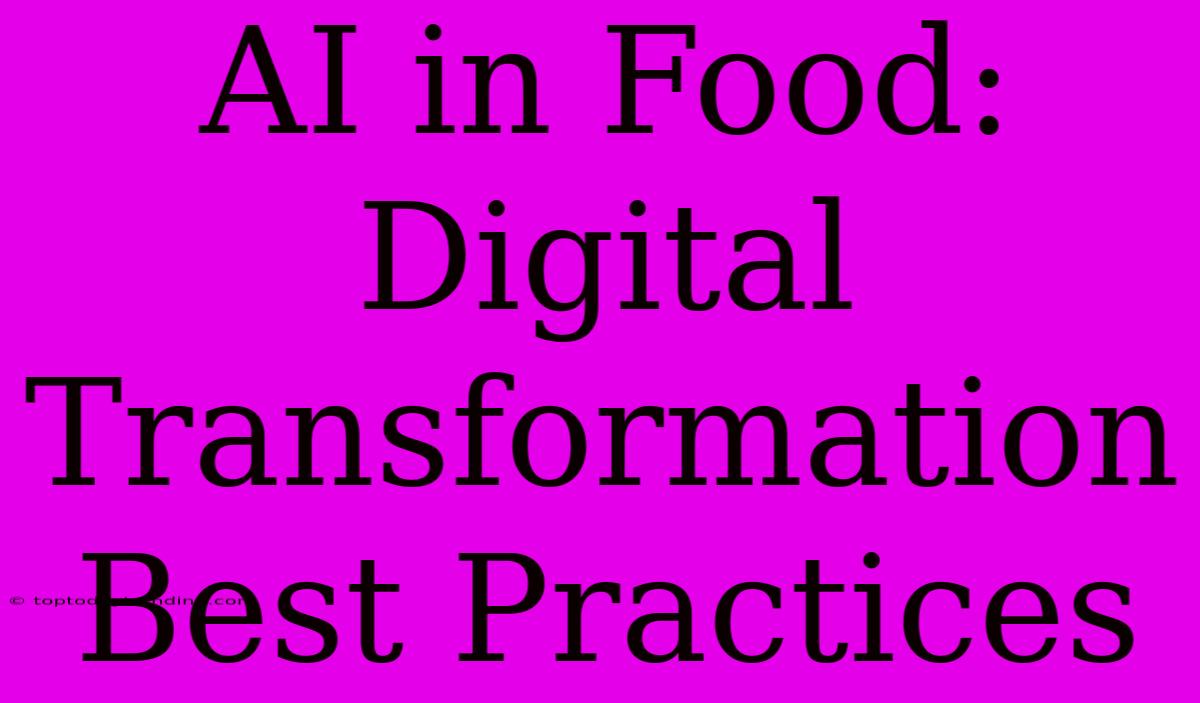AI in Food: Digital Transformation Best Practices
The food industry is undergoing a rapid digital transformation, driven by the power of artificial intelligence (AI). From farm to fork, AI is revolutionizing every stage of the food supply chain, leading to greater efficiency, sustainability, and quality. This article explores best practices for leveraging AI in the food industry to achieve successful digital transformation.
1. Identify Clear Objectives and Use Cases
The first step towards a successful AI implementation is defining clear objectives and identifying specific use cases. Consider the following questions:
- What are your primary challenges? Are you struggling with food waste, supply chain inefficiencies, or inconsistent product quality?
- How can AI address these challenges? Explore specific AI solutions, such as predictive analytics for demand forecasting, computer vision for quality control, or robotics for automation.
- What are your desired outcomes? Do you aim to increase productivity, reduce costs, or improve consumer satisfaction?
2. Focus on Data Quality and Accessibility
AI thrives on data, and its success heavily relies on the quality and accessibility of the data you feed it.
- Data Collection: Invest in robust data collection systems and ensure accurate and reliable data capturing across all stages of the food supply chain.
- Data Cleaning and Preprocessing: Implement processes to clean and pre-process your data, removing errors and inconsistencies.
- Data Storage and Security: Utilize secure and scalable data storage solutions to manage your growing data volume.
3. Choose the Right AI Technologies
Not all AI technologies are created equal. Select the appropriate AI tools for your specific needs, considering factors such as:
- Machine Learning: For analyzing data patterns, predicting outcomes, and making recommendations.
- Deep Learning: For complex tasks like image recognition, natural language processing, and predictive modeling.
- Computer Vision: For automating visual inspections, analyzing product quality, and monitoring food safety.
- Robotics: For automating repetitive tasks, improving efficiency, and minimizing human error.
4. Start Small and Scale Gradually
Avoid attempting to implement AI across all operations at once. Start with a pilot project in a specific area, such as optimizing inventory management or improving crop yields. This allows you to test the technology, gather valuable insights, and ensure a smooth transition.
5. Embrace Collaboration and Partnerships
Successful AI implementation requires collaboration between different departments within your organization and external partnerships.
- Internal Collaboration: Involve IT, operations, and data science teams to ensure a seamless integration of AI into existing systems.
- External Partnerships: Collaborate with AI technology providers, data scientists, and industry experts to leverage their expertise and access advanced solutions.
6. Invest in Training and Skill Development
AI requires specialized skills. Invest in training programs to equip your workforce with the necessary knowledge and expertise to understand, use, and manage AI technologies effectively.
7. Ensure Ethical and Responsible AI Use
Ethical considerations are paramount in the food industry. Ensure your AI solutions are transparent, fair, and unbiased, and comply with all relevant regulations and standards.
8. Continuously Monitor and Evaluate
AI is an iterative process. Continuously monitor the performance of your AI solutions, gather feedback, and make necessary adjustments to optimize outcomes and ensure continuous improvement.
Examples of AI Applications in the Food Industry
- Precision Agriculture: Optimizing crop yields, reducing water consumption, and minimizing pesticide use.
- Supply Chain Management: Optimizing logistics, predicting demand, and reducing waste.
- Food Safety and Quality Control: Detecting contaminants, identifying defects, and monitoring food spoilage.
- Personalized Nutrition: Tailoring recommendations based on individual dietary needs and preferences.
Conclusion
AI presents a transformative opportunity for the food industry to enhance efficiency, sustainability, and quality. By implementing best practices, focusing on data, choosing the right technologies, and embracing collaboration, food businesses can harness the power of AI to drive successful digital transformation and create a more sustainable and efficient food system.

